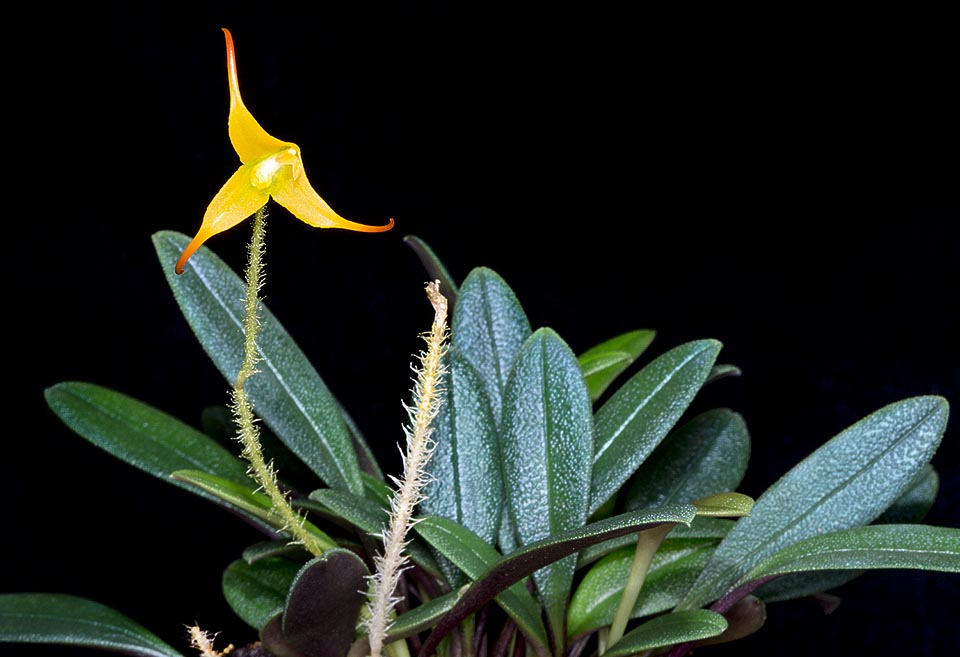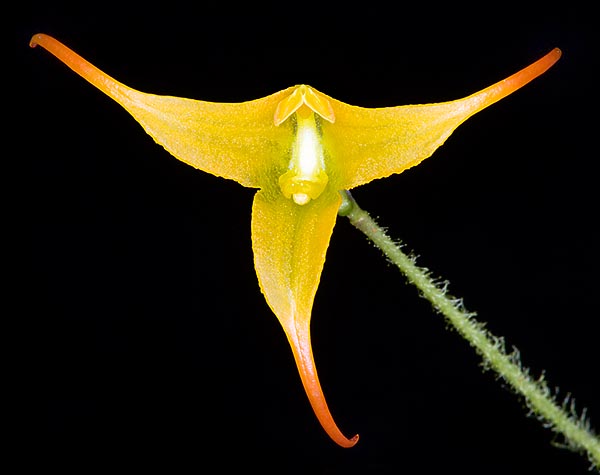Family : Orchidaceae

Text © Pietro Puccio

English translation by Mario Beltramini
The species is native to Colombia, Ecuador and Venezuela where it grows in the humid forests between the 1500 and the 2700 m of altitude.
The name of the genus is the combination of the Greek adjective “πόρρω” (porro) = forward, and of the Greek substantive “γλῶσσα” (glossa) = tongue, with reference to the position of the labellum; the specific name is the Latin adjective “muscosus, a, um” = mossy, covered by moss, with reference to the long down on the peduncle.
Common names: sensitive orchid (English).

Epiphyte or lithophyte in Colombia, Ecuador and Venezuela humid forests at altitude, Porroglossum muscosum tends to form tufts, starting from a creeping rhizome with many small stems having only one 5-12 cm leaf. Inflorescences on hairy peduncle, as the specific name states, with few flowers opening gradually © Giuseppe Mazza

The flower labellum is mobile and clicks like a trap to stick the pollen sacs to the pollinator on duty © Giuseppe Mazza
The main attraction of this orchid, yet rarely cultivated, is the particular mechanism of pollination that since ever has drawn the attention of the scholars. It requires a shady position, intermediate temperatures, 16-28 °C, with lowest winter values not under the 12 °C, high atmospheric humidity and constant ventilation. Regular waterings, thus to maintain the substratum constantly humid, but without stagnations, cause of rotteness, utilizing rain water, demineralized or by reverse osmosis. Monthly fertilizations, from spring to autumn, with hydrosoluble balanced product, with microelements, at ¼ of the dosage suggested on the package. It can be mounted on trunks, bark pieces or rafts of cork or of roots of arborescent ferns covered by a layer of moss, or cultivated in pots or baskets with medium sliced fragments of bark and of charcoal and moss. Transplants and repottings are to be done at the vegetative restart.
The species is reported in the appendix II of CITES (species whose trade is internationally ruled).
Synonyms: Masdevallia muscosa Rchb.f. (1875); Masdevallia xipheres Rchb.f. (1876); Scaphosepalum xipheres (Rchb.f.) Schltr. (1920); Porroglossum xipheres (Rchb.f.) Garay (1967).
→ For general notions about ORCHIDACEAE please click here.
